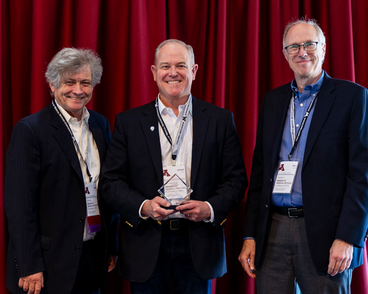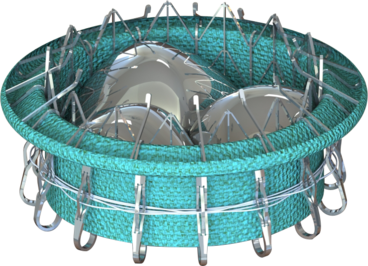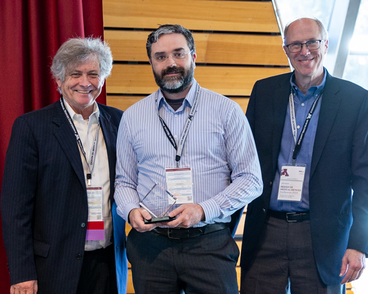Researchers and inventors will get immediate feedback about their projects from leaders in the fields of medical technology research, engineering & development.
Winners will be announced during lunch following the competition on Tuesday.
Competition Judges:
Mike Finch, Carlson School of Management
Filip Kostal, Medical Alley
John Heinbigner, EY
Beth Lindborg, Sarcio, Inc.
Paul Gam, Zurich Medical
Cellulora Injectable Long-Term Implants (Grand Prize)
Cellulora implants are plant-based, non-degradable, yet reversible. They prepare in minutes and are delivered via a small 25-gauge needle. There is a large and unmet need for an effective biomaterial that can be used anywhere in the human body to replace soft tissue. Our implants provide an immediate bulking effect for visualization and do not require a blood supply. Dual thermal gelation and chemical crosslinking prevent migration, resorption, or contraction, and unique surface chemistry resists fibrous encapsulation. Additionally, if the patient or physician are unhappy with the implant, in vitro studies show it can be reversed via enzymatic cellulase treatment. All of our implants are compatible with drugs, stem cells, and nano particles.

Steve Davis, CEO
Cellulora
Cellulora is developing injectable long-term implants for soft tissue bulking and filling that are unique because they are non-degradable yet reversible. They’re biocompatible and do not require a blood supply. The company is led by Steven Davis, thirty-year veteran of medical device start-ups and Steven Nicoll PhD, biomedical engineering professor and expert in tissue engineering and biomaterials. In addition to our long-term implants, we also have a dissolvable version and adhesive in development. Cellulora was granted Breakthrough Device Designation from the FDA and anticipates initiating first-in-human studies next year. Based on acquisitions of similar types of technology and conversations with large companies, we believe initiating human trials will create a big value inflection for our company and investors.
Trinity Tube & Palm Reader (2nd Place)
Trinity Tube is an innovative flexible catheter, that integrates feeding, venting, and non-invasive vital signs monitoring, providing a comprehensive solution to improve the care and comfort of premature infants while enhancing the effectiveness of respiratory support methods like HFNC.

Iman Slafian, Ph.D. Student & Research Assistant at the Medical Device Lab, Lead Entrepreneur
Iman is a certified project manager and mechanical engineer with more than 7 years of experience in the manufacturing and medical device industry. He is currently pursuing a Ph.D. in mechanical engineering focusing on biomechanics at the Walker Department of Mechanical Engineering at the University of Texas at Austin. His research is centered on developing non-invasive vital sign monitoring devices for neonates and pediatric patients. As the lead entrepreneur, Iman is navigating the commercialization of two innovative pediatric medical technologies, Trinity Tube and Palm Reader.
3D Nitinol Thin Film Heart Valve Leaflets (3rd Place)

Nininger Medical is developing transformative material for heart valve leaflets using vacuum-deposited nitinol thin film, and a tricuspid replacement using this material. This material has several advantages over the technology currently used in most heart valve replacement devices--it will last longer in the body without calcifying--delaying or preventing the need for re-intervention, it can fit in smaller delivery catheters--enabling treatment for more patients, and it will be less expensive to manufacture--saving valuable healthcare dollars.

Daniel C. Anderson, Founder/CEO
Dan Anderson has 20 years of device development experience at both start-ups and large companies, including development of 4 structural heart projects: adjustable mitral annuloplasty (MiCardia’s enCorSQ), transcatheter tricuspid repair (Edwards’ Forma), TAVR delivery systems (JenaValve), and mitral replacement (Marvel) which have provided important insights into the current need for trancatheter devices. Dan is co-founder and inventor of Nininger Medical's novel leaflet technology using 3D nitinol thin film.
Epilog
Epilog aims to reduce the missed diagnosis of non-convulsive status epilepticus (SE) - a serious form of seizure with a pediatric mortality rate of 30% and a time window on the scale of minutes for detection and treatment. Existing at-home seizure detection devices cannot reliably detect non-convulsive seizures, and most SE diagnoses are provided on qualitative information and are often confused with normal post-seizure fatigue. Epilog is a rapid-application electroencephalography (EEG) headband that can be rapidly and easily applied, collect EEG data, process it in real-time, feed a custom machine learning algorithm, and display results in a mobile application that alerts a caretaker to take immediate medical action if SE is detected. With a powerful, lightweight algorithm and a non-invasive wearable, Epilog enables fast, data-driven decision-making for SE.
Rohan Chhaya, Carly Flynn, Elena Grajales, Priya Shah, Doris Xu
The Epilog design team consists of undergraduate and graduate students in the Department of Bioengineering at the University of Pennsylvania. The team collaborated with physicians at the Children’s Hospital of Philadelphia and faculty at the University of Pennsylvania in the development of their device. The team’s research interests and experience span the biomedical applications of bioelectronics, machine learning and artificial intelligence, and brain-computer interfaces. They plan to further explore this space after graduating from their degree programs, in both academia and industry.
SlipSpeed Chest Tube Inserter
The SlipSpeed chest tube inserter is designed to confront an unaddressed procedural challenge which contributes to the 30% complication rate of the tube thoracostomy procedure. This procedure rapidly (<1min) restores breathing by inserting a large chest tube into the pleural cavity to drain accumulated blood or trapped air which causes a collapsed lung. Difficulty in accurately navigating the chest tube into the body, through the dense tissue of the chest wall and into the pleural cavity at a safe trajectory, can lead to complications such as organ punctures and tube malfunctions which harm patients and increase hospital cost by up to 21x. SlipSpeed has a novel mechanism which gives physicians greater control over their tube insertion trajectory compared to the current procedural technique and provides reliable blunt dissection through tissue, while maintaining a defined tract and predictable access into the pleural cavity along this trajectory during tube insertion.
Luke Jewett and Rishi Rajendran
Development of the SlipSpeed device has been driven by a team of eight graduate and undergraduate engineering students from Duke University and through collaboration with faculty from the Department of Biomedical Engineering at Duke University and physicians from the Duke University Hospital. Collectively, team members hold degrees in biomedical engineering, mechanical engineering, and electrical engineering, and they have acquired cross-functional medical device development experience through professional roles in R&D, design for manufacturing, systems engineering, manufacturing, and quality. Following their graduation from Duke, they are transitioning into roles within the medical device industry to further explore their interests and develop their skill sets.
Alina: AI Vision enabling Surgeons avoid and preserve nerves in real-time
The Alina product is a real-time AI powered imaging system that utilizes a patent pending combination of polarized light imaging and diffuse reflectance spectroscopy to provide surgeons unparalleled resolution and detection of nerves. This technology will allow surgeons to not only identify nerves but eventually different tissue types in real-time and make available user-friendly mapping of these various tissues to highlight regions not easily visible to the human eye leading to more efficient and safer surgeries. Our label-free, non-contact device has successfully demonstrated significant improvements in nerve visualization and identification in preclinical pilot studies using a rat surgery model. While this device can have utility in numerous medical applications, our initial focus is to target the accidental nerve injury prevention market.
Justin Baba, PhD
Associate Research Professor of Biomedical Engineering, Vanderbilt University; Associate Director, Vanderbilt Biophotonics Center of Engineering; Unleashed Fellow
Baba’s research and patent portfolio are focused on the development and translation of non- and minimally invasive biomedical sensing, diagnostic, monitoring and therapeutic technologies. He is the founder and chief scientific officer for Yaya Scientific, a Nashville-based engineering start-up, founded in 2019, that develops diagnostic, therapeutic and integrated hardware solutions for biomedical problems. He worked at ORNL from 2003 to 2018, developing and advancing biomedical applications for DOE’s Office of Science technology portfolio. He has been designated as a “Distinguished Inventor,” being recently inducted into an elite group of ORNL inventors that are recognized for achieving at least 14 ORNL US issued patents and is the first person of African origin to achieve this milestone. Several of his inventions have been licensed, implemented for commercialization, and have undergone clinical trials for which he has received numerous UT-Battelle Technology Commercialization and UT-Battelle Technology Partnerships Awards.
Duza Baba
Business Strategy and Development, Yaya Scientific
An experienced healthcare strategist and analytics expert with over 15 years of proven success navigating complex landscapes. He excels in strategic decision-making, coalition building, and team leadership. As a trained epidemiologist and health economist he possesses a keen understanding of healthcare dynamics and data-driven insights essential for developing impactful biomedical solutions. He leads Business Strategy and Development for Yaya Scientific.